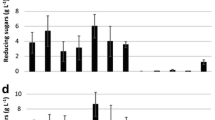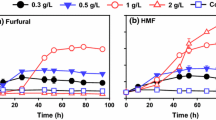Abstract
Bioabatement is a potential method to remove inhibitory compounds from lignocellulose hydrolysates that could be incorporated into a scheme for fermentation of ethanol from cellulose. Coniochaeta ligniaria NRRL30616, an Ascomycete that metabolizes furfural and 5-hydroxymethylfurfural, is a unique strain that may be useful for detoxifying biomass sugars. NRRL30616 and 23 related fungal strains were screened for the ability to metabolize furans and grow in dilute-acid hydrolysate of corn stover. NRRL30616 was the best strain for removal of inhibitors from hydrolysate, and abatement of hydrolysate by inoculation with the strain allowed subsequent yeast fermentation of cellulose to ethanol.
Similar content being viewed by others
References
Hsu, T.-A. (1996), in Handbook on Bioethanol: Production and Utilization, Wyman, C. E., ed., Taylor & Francis, Washington, DC, pp. 179–212.
Luo, C., Brink, D. L., and Blanch, H. W. (2002), Biomass Bioenergy 22, 125–138.
Chen, W., Brühlmann, F., Richins, R. D., and Mulchandani, A. (1999), Curr. Opin. Biotechnol. 10, 137–141.
Watanabe, K. (2001), Curr. Opin. Biotechnol. 12, 237–241.
Wagner, M. and Loy, A. (2002), Curr. Opin. Biotechnol. 13, 218–227.
Nagarathnamma, R. and Bajpai, P. (1999), Appl. Environ. Microbiol. 65, 1078–1082.
Raghukumar, C., Mohandass, C., Kamat, S., and Shailaja, M. S. (2004), Enzyme. Microb. Technol. 35, 197–202.
Mussatto, S. I. and Roberto, I. C. (2004), Bioresour. Technol. 93, 1–10.
López, M. J., Nichols, N. N., Dien, B. S., Moreno, J., and Bothast, R. J. (2004), Appl. Microbiol. Biotechnol. 64, 125–131.
Weber, E. (2002), Nova Hedwigia 74, 159–185.
Weber, E., Görke, C., and Begerow, D. (2002), Nova Hedwigia 74, 187–200.
Ho, N. W. Y., Chen, Z., Brainard, A. P., and Sedlak, M. (1999), Adv. Biochem. Eng. Biotechnol. 65, 163–192.
Gerhardt, P., Murray, R. G. E., Wood, W. A., and Krieg, N. R. (1994), Methods for General and Molecular Bacteriology, American Society for Microbiology, Washington, DC.
Nichols, N. N., Dien, B. S., and Bothast, R. J. (2003), J. Ind. Microbiol. Biotechnol. 30, 315–321.
Dien, B. S., Bothast, R. J., Nichols, N. N., and Cotta, M. A. (2002), Int. Sugar J. 104, 204–211.
Palmqvist, E. and Hahn-Hägerdal, B. (2000), Bioresour. Technol. 74, 17–24.
Palmqvist, E. and Hahn-Hägerdal, B. (2000), Bioresour. Technol. 74, 25–33.
Schneider, H. (1996), Enzyme. Microb. Technol. 19, 94–98.
Jönsson, L. J., Palmqvist, E., Nilvebrant, N.-O., and Hahn-Hägerdal, B. (1998), Appl. Microbiol. Biotechnol. 49, 691–697.
Modig, T., Lidén, G., and Taherzadeh, M. J. (2002), Biochem. J. 363, 769–776.
Zaldivar, J., Martinez, A., and Ingram, L. O. (1999), Biotechnol. Bioeng. 65, 24–33.
Larsson, S., Quintana-Sáinz, A., Reimann, A., Nilvebrant, N.-O., and Jönsson, L. J. (2000), Appl. Biochem. Biotechnol. 84–86, 617–632.
Martinez, A., Rodriguez, M. E., Wells, M. L., York, S. W., Preston, J. F., and Ingram, L. O. (2001), Biotechnol. Prog. 17, 287–293.
Olsson, L. (1994), PhD thesis, University of Lund, Lund, Sweden.
Author information
Authors and Affiliations
Corresponding author
Additional information
Mention of trade names or commercial products in this article is solely for the purpose of providing specific information and does not imply recommendation or endorsement by the U.S. Department of Agriculture.
Rights and permissions
About this article
Cite this article
Nichols, N.N., Dien, B.S., Guisado, G.M. et al. Bioabatement to remove inhibitors from biomass-derived sugar hydrolysates. Appl Biochem Biotechnol 121, 379–390 (2005). https://doi.org/10.1385/ABAB:121:1-3:0379
Issue Date:
DOI: https://doi.org/10.1385/ABAB:121:1-3:0379




